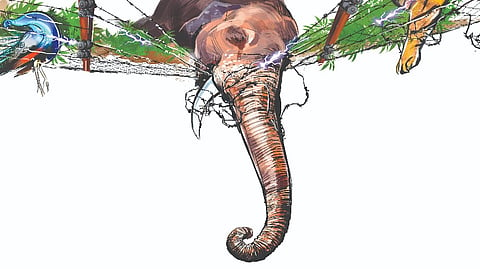

CHENNAI: Tamil Nadu recently celebrated World Elephant Day and the State policymakers were enthralled with the announcement of Agasthiyarmalai Elephant Reserve (1,197.48 sq km in Kanniyakumari and Tirunelveli) by the Union government. Thought it’s the 5th reserve in Tamil Nadu, a lot of bitter developments and activities continue to affect the pachyderm and the wildlife population in the state.
Electrocution deaths, habitat fragmentation and failure to adopt alternate crops are issues affecting big mammals and the other wild animals in the state.
Tamil Nadu is home to about 3,000-4,000 elephants that migrate across The Nilgiris landscape spread over Tamil Nadu, Kerala and Karnataka. Less than 40% of fatalities are recorded, as there are barely any shred of evidence of large animals like elephants and tigers when they die.
The small mammals like rodents, peacocks, wild boars and small jungle cats go unnoticed or they’re cleared within a few days by the natural scavengers inside the forests, admitted confidential sources with the Tamil Nadu Forest department.
When DT Next spoke to a senior official at forest department, the official said, “Habitat fragmentation and deterioration of forests are the main issues forcing the animals to migrate, but these are policy decisions taken up at the centre and state levels.”
Coming back to electrocution deaths, the forest guards on duty perambulate the forest boundaries looking out for illegalities like unauthorised power connections, movement of poachers and miscreants. In the case of solar fencing, there is no problem. But due to electric fencing, there have been 3 human deaths in the past two years and more than 6 large animals have died during the same period. All these cases are under court trial and investigations.
There is no proper policy in place as 3 departments are involved in monitoring the issue – forest, electricity board and revenue department. “EB department plays a major role in arresting electrocution deaths,” the official clarified.
One of the major problems is the failure of the State to help farmers in adopting alternate crops along the forest boundaries, explains wildlife activist K Mohanraj of Coimbatore. “Advising farmers to adopt alternate crops is easy but the State should come out with beneficiary schemes for farmers to alter the farming pattern for the sake of wildlife,” he adds.
Farmers can cultivate alternate flower crops like kanagambaram and jasmine, drumstick, lemon, chilli, and grains. These don’t attract elephants, wild boars and other mammals.
“They should be made aware of this, and be provided logistical support,” says. “Alternate crops will reduce crop loss and minimise human-animal conflicts. If alternate crops are adopted, there’s no need for the electrical fence that pose danger to humans and animals.”
AGASTHIYARMALAI ELEPHANT RESERVE
• The proposal by forest department to designate 1,197.48 sq km in Kanyakumari and Tirunelveli as the Agasthiyarmalai Elephant Reserve was approved by the Union Environment Ministry recently.
• Tamil Nadu will oversee this area, which is the fifth elephant reserve.
• Asian elephants in the Periyar-Agasthyamalai landscape are estimated to be 1,800 (Census 2010).
• The forest department may be eligible for additional financing through the centrally sponsored Project Elephant
• Around 300 are found on the southern side of the reserve and Mahendragiri hill ranges in the Neyyar, Shendurney, and Peppara wildlife sanctuaries and Kalakkad-Mundanthurai Tiger Reserve – all located in Thiruvananthapuram Forest Division.
SHOCKING FACTS
• Incidence of wildlife electrocution higher in Coimbatore – Mettupalayam, Gudalur, Erode, Sathayamangalam and Valparai.
• In the past 10 years, over 80 wild elephants killed in train accidents and electrocution.
• Less than 40% of electrocution recorded, as evidence of large animals like elephants and tigers when they die.
• Farmers purchase electricity products via online platforms, which are not BIS authorised.
• As per norms, electrical fencing should not exceed 5 joules, but 100 joules given near forest region to protect farm land.
Visit news.dtnext.in to explore our interactive epaper!
Download the DT Next app for more exciting features!
Click here for iOS
Click here for Android